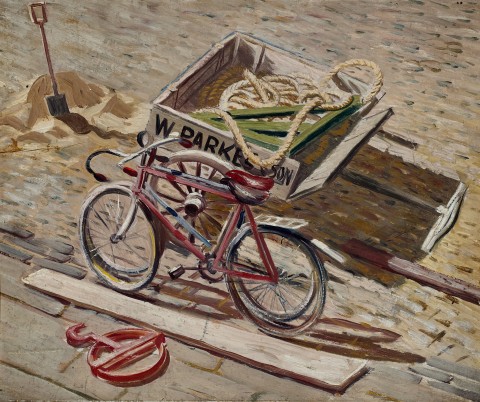THE CART, c.1936
WILLIAM DOBELL
oil on wood panel
29.5 x 35.5 cm
bears inscription on plaque attached verso: “The Cart” / William Dobell
bears inscription with title on frame verso: The Cart
Walter and Hedy Magnus, Sydney, acquired directly from the artist (bears inscription verso)
Thence by descent
Michael Magnus, son of the above, from 1954
Barry Stern Galleries, Sydney (inscribed verso, stock no. 23)
Southern Cross Galleries, Melbourne (partial label attached verso)
Private collection
Leonard Joel, Melbourne, 9 November 1999, lot 180
Joseph Brown Gallery, Melbourne
The Cbus Collection of Australian Art, Melbourne, acquired from the above on 11 November 1999
on long term loan to Wollongong City Gallery, New South Wales
Nainby, B., Stanhope, Z., and Furlonger, K., The Cbus Collection of Australian Art, in association with Latrobe Regional Gallery, Melbourne, 2009, pp. 59 (illus.), 217
The cart, c.1936, belongs to suite of paintings of worker’s vehicles that Dobell observed from the window of his studio in Pimlico in the heart of Cockney London. He had travelled to England in 1929 (having won the £500 Society of Artists’ travelling scholarship) and studied for a short time at the Slade School of Fine Art whilst taking private lessons from Sir William Orpen. He then travelled twice to Europe for short journeys absorbing the works of Rembrandt, Van Gogh, Velásquez and others before returning to London to continue painting. After a few years of frugal living, ‘poverty brought him to the dingiest bed-sitting rooms of Pimlico and Bayswater.’1 Dobell always carried a sketch book with him but hated people observing him at work so when the New Zealand artist Fred Coventry offered his colleague the use of his studio whilst away, Dobell found a perfect first-floor vantage point from which to observe the passing parade. This comprised ‘charladies, ‘nippies’ (housemaids), gossiping cockney women, traders with horse-drawn carts, women cleaning front steps and many others’2 whom he was able to sketch and paint without interruption.
During these years, Dobell’s images oscillated between a crystalline realism and a semi-expressionist style which became more prominent in his paintings from the 1940s onwards. The cart belongs to the former category and he was no doubt drawn to the accidental composition of diagonals caused by the bicycles, plank and cart, contrasting with exclamation point of the shovel, the tangle of rope, and the circular forms of the wheels. It is, as described by his biographer James Gleeson, a scene where ‘the commonplace [becomes] unique; [Dobell] sees the ugly and paints it as though it was beautiful.’3 The cart is a view of a now vanished London street life that even Mr Parkes (and son) would appreciate. In related works such as The dust cart, The dirt cart and The baker’s cart, Dobell distorts his subjects with busy brushwork but in The cart, he remains true to the original scene in a manner akin to his other London masterworks such as Boy at the basin, 1932, and A street in Pimlico, 1937 (both Art Gallery of New South Wales), and Billy Frost, 1932 (National Gallery of Australia). Dobell returned to Australia with The cart in 1939 where the painting was subsequently purchased by the expansive restauranteur Walter Magnus, whose own portrait by Dobell, Chez Walter, 1945 (National Gallery of Australia) is another highlight from the artist’s oeuvre.
1. Gleeson, J., William Dobell, Thames and Hudson, London, 1964, pp.37 – 38
2. Donaldson, E., William Dobell: an artist’s life, Exisle Publishing, NSW, 2010, p.45
3. Gleeson, J., ibid., p.30
ANDREW GAYNOR
